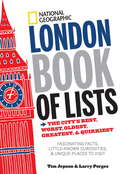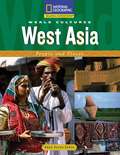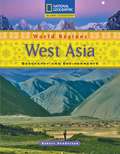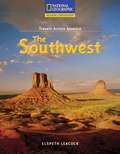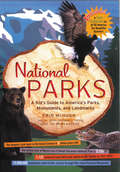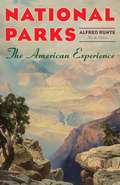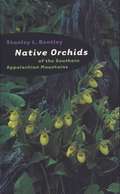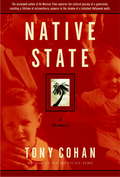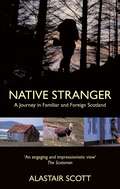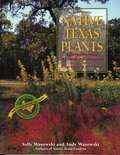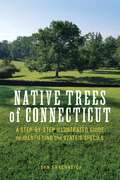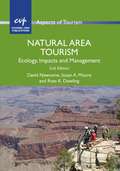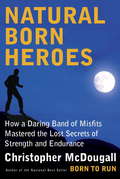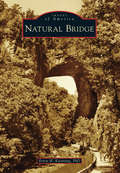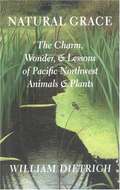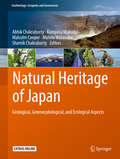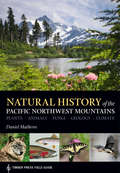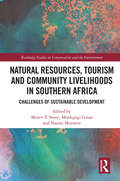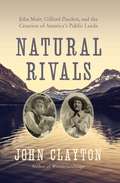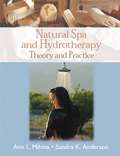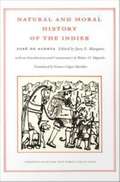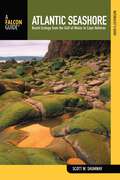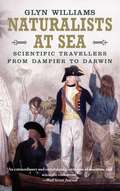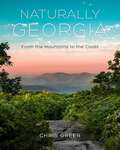- Table View
- List View
National Geographic London Book of Lists: The City's Best, Worst, Oldest, Greatest, and Quirkiest
by Tim JepsonOrganized with a minimum of organization, the 140 lists in this eclectic and hugely entertaining illustrated compendium cover the city's best, worst, highest, smallest, first, last, and everything in-between. Among the many intriguing facts, stats, and snippets, you'll discover: Where you can find six old windmills within the confines of metropolitan London; Why the women's restroom at an East End pub is especially popular with avant-garde artists; When a tornado razed nearly 600 houses and destroyed London Bridge; The address of the only London flat where the four members of the Beatles lived together; Why local children beat the stone boundaries outside the Tower of London with willow branches every three years; Where you can find London's eight best waterfront pubs, seven greatest Victorian gin palaces, and ten most historic pubs; Which two famous London museums still show World War II bomb damage on their outer walls Royal palaces. Street markets. Stellar views. Cockney slang. Favorite meals of kings. Roman ruins. Secrets lost to time. With surprises on every page, National Geographic London Book of Lists takes you deep inside the city that never fails to fascinate.
National Geographic Map Essentials: A Comprehensive Map Skills Program
by National Geographic Society (U.S.) StaffThis is a comprehensive book from National Geographic that enables kids to learn about maps.
National Geographic Reading Expeditions World Cultures: West Asia People and Cultures
by Eden Force EskinDiscusses West Asia's ancient civilizations today. Examines what it is like to live or travel in these lands of arid desert and monsoon rains.
National Geographic Reading Expeditions: Geography and Environments
by Robert HendersonClimb to the top of Mount Everest, the world's tallest mountain. Float in the Dead Sea, the lowest place on Earth's surface. Celebrate the arrival of the monsoon rains in India, and walk through countries where most of the land is desert.
National Geographic: The Southwest (Travels Across America)
by National Geographic School PublishingThe book guides you as to explore the Southwest region. You are taken on a tour to visit the states of Texas, Oklahoma, New Mexico, and Arizona.
National Parks: A Kid's Guide to America's Parks, Monuments, and Landmarks, Revised and Updated
by Erin McHugh Neal Aspinall Doug Leen Brian MaebiusCalling all Junior Rangers! This fun-filled guide explores the wonders and weirdness of more than 75 U.S. parks, monuments, and landmarks, from Acadia to Zion. From Yellowstone to the Statue of Liberty, from Gettysburg National Battlefield to Mount Rushmore, National Parks is the only kid-friendly, family-oriented book that covers all of the 60 U.S. national parks, plus other famous monuments and landmarks. With a lively text and hundreds of color illustrations and photographs throughout, this updated edition offers fascinating, memorable information on every aspect of the parks, such as the history, geography, natural wonders, native wildlife and birds, and unique features that make each park special. Organized alphabetically by state, National Parks takes readers on a whirlwind trip to 75 locations, including Denali National Park, Hot Springs National Park, Everglades National Park, Fort McHenry, White Mountain National Forest, Ellis Island, the Blue Ridge Parkway, Zion National Park, Block Island National Wildlife Refuge, Mt. Hood National Forest, and many more.
National Parks: The American Experience
by Alfred RunteThe National Parks: America's Best Idea," Alfred Runte is renowned as the nation's leading historian on the meaning and management of these treasured lands. Lavishly illustrated with period photographs, including eight pages of color paintings, National Parks: The American Experience has never been more beautiful or profound. This remains a stirring look into the lands that define America, from Yosemite and Yellowstone to wilderness Alaska.
Native Orchids of the Southern Appalachian Mountains
by Stanley L. BentleyThis authoritative guide showcases the unmatched beauty and diversity of the native orchids of the southern Appalachian mountains. Based on Stanley Bentley's many years of nature study, it covers the 52 species--including one discovered by Bentley and named after him--found in a region encompassing western Virginia and North Carolina and eastern West Virginia, Kentucky, and Tennessee.The entry for each orchid provides the plant's scientific and common names, a description of the flower (including color, shape, and size), and information on the time of flowering, range, and typical habitat, all in the context of the southern mountains. A range map accompanies each description, and Bentley's own superb photographs are an additional aid to identification.Using straightforward language yet incorporating the most up-to-date scientific information and nomenclature, the book will be welcomed by amateur naturalists or professional botanists looking for species in the field and by those who simply enjoy photographs of beautiful wildflowers.
Native State: A Memoir
by Tony CohanA captivating, deeply affecting memoir chronicling a journey from a Hollywood childhood as the son of a fading show business figure to a bohemian life in Europe and back to his native state of California, where the author must face the man who had driven him away. Summoned from abroad to attend to the ninety-four-year-old father he’s never been close to, writer and musician Tony Cohan finds himself reliving his own peripatetic life—a kaleidoscopic odyssey from California’s sunny postwar promise through the burnt end of the 1960s to the final days of the last century.An engrossing investigation of memory and identity, love and desire, art and fate, Native State vividly portrays the author’s attempts to escape the confines of a celebrity-filled, alcoholic family through music, writing, and travel. His descent into the colorful milieus of musical and literary geniuses and lowlifes, divas and crooks, fortune tellers and culture gods in Paris, Tangier, London, Copenhagen, Barcelona, San Francisco, Kyoto, and Los Angeles coalesces into a distinctive, intimate depiction of a pivotal cultural era. Throughout, Cohan brilliantly interweaves and contrasts his past experiences with his present-day reflections on the universal youthful desire to flee home and family, and the simultaneous “undertow of origins” urging a return. The result is a work that combines unusually rich storytelling with extraordinary literary quality.Poignant, elegantly crafted, and often funny, Native State is an indelible portrait of the artist as a young man, and—as son and dying father grope toward acceptance—a coming-to-terms with self, family, origins, and the elusive American idea of home.
Native Stranger: A Journey in Familiar and Foreign Scotland
by Alastair ScottAfter ten years of wanderlust which took him to nearly seventy countries around the world, Alastair Scott decided it was time to make 'home' his destination. Resolving to explore Scotland and the Scottish people in as much depth and breadth as possible, the author drew up an itinerary which would take him from the outermost isle to the innermost city, sampling the experiences of modern Scotland in all their diversity. Encompassing issues of the land, eccentrics in castles, the state of the Gaidheal, homelessness in Edinburgh, and all the idiosyncrasies of history, development and decline in between, Scott's journey covered four thousand miles of island, mountain and lowland. The variety of place and circumstance was exceeded only by that of the characters encountered en route. The result is a detailed and engrossing portrait of contemporary Scotland, and of one man's rediscovery of his native land.
Native Texas Plants: Landscaping Region by Region
by Sally Wasowski Andy WasowskiAn indispensable guide with 21 landscaping design plans for every type of terrain found in Texas.
Native Trees of Connecticut: A Step-by-Step Illustrated Guide to Identifying the State's Species
by John EhrenreichThere are 75 trees native to the Nutmeg State, all of which can be found in its forests and parks, and even your own backyard!Native Trees of Connecticut is a step-by-step illustrated guide to identifying Connecticut&’s trees. It provides easily observable characteristics that can help you recognize each species of tree.This guide describes each tree&’s overall shape and form when grown in an open area, provides a detailed description and photographs of leaves and bark, indicates the habitat in which the tree is typically found, and discusses the significance of the tree for wildlife. Flowers, buds, and fruits are also described and pictured when they are useful for identification. Additional sections focus on helping to distinguish among similar species of a single genus, such as the four species of hickory found in Connecticut, and on supplementary information about trees, including explanations of the functions of bark and leaves, tree habitats, and a guide to estimating age.
Natural Area Tourism
by David Newsome Susan A. MooreNatural Area Tourism provides a comprehensive description of tourism in natural areas allowing readers to understand the scope of, complexities arising from, and possibilities of undertaking successful tourism developments in natural areas. Furthermore, the second edition contains an overview of recent developments, such as mountain biking, adventure activities in protected areas and geotourism. There is new content and examples from the Asian region on managing the tourism industry and management effectiveness. The book also considers important new developments in monitoring, such as remote sensing and the use of GIS, as well as the use of electronic educational resources in delivering interpretation. Attention is given to the implications of climate change, inadequate protected area security and the ever-increasing influence of the landscape matrix. Moreover, the second edition includes a comprehensive review of the new literature that has emerged since the publication of the first edition more than a decade ago. Accordingly this book will remain an invaluable resource and account of natural area tourism for many years to come.
Natural Born Heroes: Mastering the Lost Secrets of Strength and Endurance
by Christopher McdougallThe best-selling author of Born to Run now travels to the Mediterranean, where he discovers that the secrets of ancient Greek heroes are still alive and well on the island of Crete, and ready to be unleashed in the muscles and minds of casual athletes and aspiring heroes everywhere. After running an ultramarathon through the Copper Canyons of Mexico, Christopher McDougall finds his next great adventure on the razor-sharp mountains of Crete, where a band of Resistance fighters in World War II plotted the daring abduction of a German general from the heart of the Nazi occupation. How did a penniless artist, a young shepherd, and a playboy poet believe they could carry out such a remarkable feat of strength and endurance, smuggling the general past thousands of Nazi pursuers, with little more than their own wits and courage to guide them? McDougall makes his way to the island to find the answer and retrace their steps, experiencing firsthand the extreme physical challenges the Resistance fighters and their local allies faced. On Crete, the birthplace of the classical Greek heroism that spawned the likes of Herakles and Odysseus, McDougall discovers the tools of the hero--natural movement, extraordinary endurance, and efficient nutrition. All of these skills, McDougall learns, are still practiced in far-flung pockets throughout the world today. More than a mystery of remarkable people and cunning schemes, Natural Born Heroes is a fascinating investigation into the lost art of the hero, taking us from the streets of London at midnight to the beaches of Brazil at dawn, from the mountains of Colorado to McDougall's own backyard in Pennsylvania, all places where modern-day athletes are honing ancient skills so they're ready for anything. Just as Born to Run inspired readers to get off the treadmill, out of their shoes, and into the natural world, Natural Born Heroes will inspire them to leave the gym and take their fitness routine to nature--to climb, swim, skip, throw, and jump their way to their own heroic feats.From the Hardcover edition.
Natural Bridge (Images of America)
by Ernst H. KastningNatural Bridge, located in the historic Shenandoah Valley, is one of the most recognized and visited geologic landmarks in the country. The massive 90-foot-wide arch spans Cedar Creek, which runs 200 feet below. Legend says that George Washington, as a young land surveyor, carved his initials on its wall. In 1774, King George III granted ownership to Thomas Jefferson. Natural Bridge was often regarded as the "Eighth Natural Wonder of the World" during the 19th and 20th centuries. The site became a popular venue for events, ranging from conventions to the annual Easter Sunrise Service. Hotels, inns, and cottages were built to accommodate travelers, and on-site attractions--including a show cave, a wax museum, and a Monacan Indian village--broadened visitor appeal. Natural Bridge remained privately owned until 2014, when the title was transferred, allowing it to become a state park; the bridge will now truly belong to the people, a concept that would have made Jefferson proud.
Natural Grace: The Charm, Wonder, and Lessons of Pacific Northwest Animals and Plants
by William DietrichThis informative and engaging selection of natural history essays is adapted from articles published in the Seattle Times magazine, Pacific Northwest. A native Washingtonian, Dietrich has watched the Northwest double in population during his lifetime. Our rapidly changing view of nature is an underlying theme throughout his wide-ranging essays, as is the timely and essential question of how best to share and conserve the natural world that drew us to the region in the first place.
Natural Heritage of Japan
by Malcolm Cooper Abhik Chakraborty Kuniyasu Mokudai Mahito Watanabe Shamik ChakrabortyThis volume brings together the geological, geomorphological and ecological aspects of Japan's natural heritage, arguing for dynamic conservation of such heritage and explaining their key characteristics in an accessible format for general readers. Sites from World Heritage Properties (Natural), UNESCO Global Geoparks, and National Parks of Japan representing key facets of this heritage are analyzed in depth, and the text is supplemented with color photographs and useful information for potential travelers. The volume is divided into thematic sections that help understand the diversity of Japan's natural heritage, with supplementary information on conservation, tourism trends, local culture and lifestyles. In addition, chapters analyzing nature's mechanisms that engender diverse heritage landscapes and conservation/sustainable management schemes make this volume a valuable resource for both general readers and those with more specialized interests.
Natural History of the Pacific Northwest Mountains: Timber Press Field Guide (A Timber Press Field Guide)
by Daniel MathewsNatural History of the Pacific Northwest Mountains is an engagingly written, portable history and identification guide for the flora, fauna, and geology of the region. This guide also includes information about the landscape and weather. Packed with 800 color photographs, this is the perfect overview of the Pacific Northwest if you are looking for a simple way to discover the great outdoors.
Natural Resources, Tourism and Community Livelihoods in Southern Africa: Challenges of Sustainable Development (Routledge Studies in Conservation and the Environment)
by Naomi Moswete Moren T. Stone Monkgogi LenaoThis book examines the connections between natural resources, tourism and community livelihood practices in Southern Africa, highlighting the successes and constraints experienced over the last 50 years. Questioning how natural resources, tourism and community livelihoods relations can positively contribute towards development efforts, this book adopts an interdisciplinary approach to understand socio-ecological systems that characterize the dynamics for sustainable development. It explores the history of conservation and natural resource management in Southern Africa and traces the development and growth of nature-based tourism. Boasting a wide range of tourism landscapes, including national parks, wetlands, forests and oceans, the book draws on case studies from a variety of Southern African countries, including Botswana, Namibia and South Africa, and considers the political challenges for implementing policies and practices. Furthermore, it analyses broader issues such as the impact of climate change, human–wildlife co-existence and resulting conflicts, poor access to funding and poverty in local communities. The book argues that the links between conservation and livelihoods can be best understood by considering the different approaches to reconciling the demands of conservation and livelihoods that have evolved over the past decades. Containing contributions from natural and social sciences the book provides guidance for practitioners and policymakers to continue to shape policies and practices that are in line with the key tenets of sustainable development. It will also be of great interest to students and scholars researching Southern Africa, sustainable tourism and conservation.
Natural Rivals: John Muir, Gifford Pinchot, And The Creation Of America's Wilderness
by John ClaytonA dynamic examination that traces the lives of two of the most influential figures—and their dueling approaches—on America's natural landscape. John Muir, the most famous naturalist in American history, protected Yosemite, co-founded the Sierra Club, and is sometimes called the Father of the National Parks. A poor immigrant, self-taught, individualistic, and skeptical of institutions, his idealistic belief in the spiritual benefits of holistic natural systems led him to a philosophy of preserving wilderness unimpaired. Gifford Pinchot founded the U.S. Forest Service and advised his friend Theodore Roosevelt on environmental policy. Raised in wealth, educated in privilege, and interested in how institutions and community can overcome failures in individual virtue, Pinchot’s pragmatic belief in professional management led him to a philosophy of sustainably conserving natural resources. When these rivaling perspectives meet, what happens? For decades, the story of their relationship has been told as a split between the conservation and preservation philosophies, sparked by a proposal to dam a remote Yosemite valley called Hetch Hetchy. But a decade before that argument, Muir and Pinchot camped together alongside Montana’s jewel-like Lake McDonald in, which was at the heart of a region not yet consecrated as Glacier National Park. At stake in 1896 was the new idea that some landscapes should be collectively, permanently owned by a democratic government. Although many people today think of public lands as an American birthright, their very existence was then in doubt, and dependent on a merger of the talents of these two men. Natural Rivals examines a time of environmental threat and political dysfunction not unlike our own, and reveals the complex dynamic that gave birth to America's rich public lands legacy.
Natural Spa and Hydrotherapy: Theory And Practice
by Sandra Anderson Ann MihinaThe recent growth of the spa industry has resulted in a need for highly educated practitioners of spa and hydrotherapy treatments. Natural Spa and Hydrotherapy: Theory and Practice is designed to meet the needs of today's spa practioners. This book can be used for spa training as well as for skill enhancement for individual therapists. It will assist students of massage and bodywork as well as practitioners in spa settings and private practice who have the desire to increase their knowledge and understanding of, and competency in, natural spa and hydrotherapy.
Natural and Moral History of the Indies
by José De AcostaThe Natural and Moral History of the Indies, the classic work of New World history originally published by José de Acosta in 1590, is now available in the first new English translation to appear in several hundred years. A Spanish Jesuit, Acosta produced this account by drawing on his own observations as a missionary in Peru and Mexico, as well as from the writings of other missionaries, naturalists, and soldiers who explored the region during the sixteenth century. One of the first comprehensive investigations of the New World, Acosta's study is strikingly broad in scope. He describes the region's natural resources, flora and fauna, and terrain. He also writes in detail about the Amerindians and their religious and political practices. A significant contribution to Renaissance Europe's thinking about the New World, Acosta's Natural and Moral History of the Indies reveals an effort to incorporate new information into a Christian, Renaissance worldview. He attempted to confirm for his European readers that a "new" continent did indeed exist and that human beings could and did live in equatorial climates. A keen observer and prescient thinker, Acosta hypothesized that Latin America's indigenous peoples migrated to the region from Asia, an idea put forth more than a century before Europeans learned of the Bering Strait. Acosta's work established a hierarchical classification of Amerindian peoples and thus contributed to what today is understood as the colonial difference in Renaissance European thinking.
Naturalist's Guide to the Atlantic Seashore: Beach Ecology From The Gulf Of Maine To Cape Hatteras (Naturalist's Guide Series)
by Scott ShumwayFrom the North Carolina's Outer Banks to Maine's rocky coast, this comprehensive guidebook covers the ecology, wildlife, plants and ocean creatures in full-color photographs and vivid detail. No other book includes all of the plants, animals, and terrain along this stretch of coastline, making this a must-have for anyone who lives or recreates near the Atlantic. The diverse habitats of the seashore, from the Rocky Shores to Sandy Beaches, Estuaries, Tidal Flats, Salt Marshes, Seagrass Meadows, and the Open Ocean are explored in detail in this user-friendly guide and natural history. The easy-to-use layout, comprehensive index, water-resistant cover and guaranteed binding make this a beautiful volume of natural history and biodiversity.Scott W. Shumway is a professor of biology at Wheaton College. He lives in Westborough, Massachusetts.
Naturalists at Sea
by Glyn WilliamsOn the great Pacific discovery expeditions of the "long eighteenth century," naturalists for the first time were commonly found aboard ships sailing forth from European ports. Lured by intoxicating opportunities to discover exotic and perhaps lucrative flora and fauna unknown at home, these men set out eagerly to collect and catalogue, study and document an uncharted natural world. This enthralling book is the first to describe the adventures and misadventures, discoveries and dangers of this devoted and sometimes eccentric band of explorer-scholars. Their individual experiences are uniquely their own, but together their stories offer a new perspective on the extraordinary era of Pacific exploration and the achievements of an audacious generation of naturalists. Historian Glyn Williams illuminates the naturalists lot aboard ship, where danger alternated with boredom and quarrels with the ships commander were the norm. Nor did the naturalists difficulties end upon returning home, where recognition for years of work often proved elusive. Peopled with wonderful characters and major figures of Enlightenment science--among them Louis Antoine de Bouganville, Joseph Banks, John Reinhold Forster, Captain Cook, and Charles Darwin--this book is a gripping account of a small group of scientific travelers whose voyages of discovery were to change perceptions of the natural world.
Naturally Georgia: From the Mountains to the Coast
by Chris GreerGeorgia is a state of great geographical diversity, and as you make your way from the Atlantic Ocean up to the temperate rainforest of the southern Appalachians, you&’ll find a lot to see. Thousands of meandering creeks twist and turn their way through the coastal marsh, filling and emptying its 400,000 acres twice a day with tides that can average seven feet or even higher. The largest blackwater swamp in North America is just inland, and from there you can trek north through the ever-changing scenery as the landscape transitions from the Coastal Plain to the Piedmont and finally to the Appalachian Mountains. There is plenty of beauty, including rolling farmland, intriguing barns, and stately old trees that have witnessed incredible change since Georgia&’s inception in 1788.It is a place of remarkable beauty that sets a perfect scene for a landscape photographer. The Mountains, the Heartland, the South, and the Coast are gorgeous backdrops where Chris Greer captures the essence of the state in this a showcase of the splendor that is Naturally Georgia.
